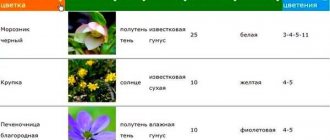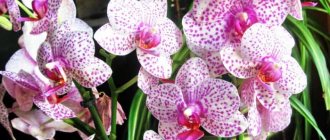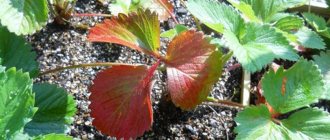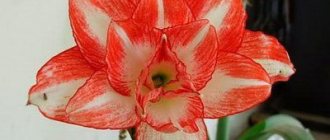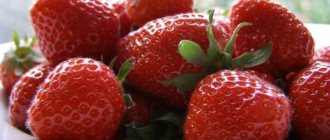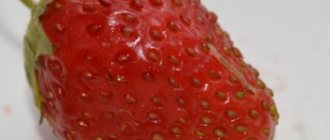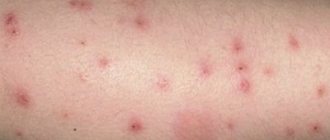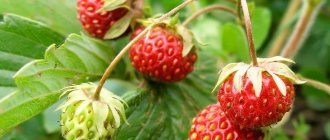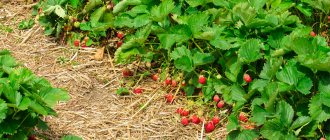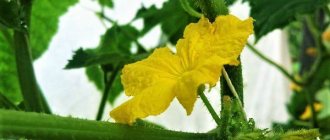Related Posts
- Diseases caused by ticks in humans, methods of their detection and treatment
- How to catch a mosquito in a room at night: methods and options
- My dog was bitten by a tick, what should I do? Symptoms, first aid and treatment regimen
It's not easy to grow healthy strawberry crops, but it's even harder to maintain a harvest of berries. A particular danger to strawberry plantings are tiny weevils that destroy the buds and thereby destroy the flowering crop. The weevil also greatly harms strawberry berries. Any gardener needs to know effective methods of controlling weevils on strawberries.
Rules for combating weevils
Timing Is it advisable to process strawberries during flowering? How to process?
Tips and tricks for gardeners
Description and types of weevils parasitizing strawberries
There are up to fifty thousand species of weevil beetles.
In this case, we can identify the main species that cause harm to cultivated plants and fruits:
- The grain weevil is the main enemy of wheat and other cereals. It may also eat corn and peas. The beetle likes to settle in storage areas and damage supplies. This is a tiny dark brown insect, 4 mm long, with a small proboscis.
- The fruit weevil causes severe damage to trees. This parasite causes damage not only to the fruits, but also to the plants themselves.
- The gray bud weevil mainly attacks the buds and leaves of fruit plants. Its larvae in the ground cause severe damage to the root system of the plant.
- The cherry weevil causes damage to cherries, cherries and sometimes plums. This is a brown beetle 4.5 mm long. Adults feed on leaves and buds. The larvae are found in the seeds of the fruit.
- The nodule weevil eats legumes (peas, soybeans, beans, lentils, etc.). These beetles eat the plant from above, and their larvae from below destroy the roots.
- The raspberry-strawberry weevil is the main pest of berries such as strawberries, wild strawberries, raspberries, etc. It is a beetle about 3 mm long with a black and brown color. The raspberry-strawberry weevil is one of the most common structurally invasive species found around homes. Both adults and larvae feed mainly on strawberries, but are also not averse to eating blackberries and evergreens such as pine and yew. This species of weevil cannot fly and disperses by crawling, which often leads it to wander into homes and other buildings.
There are also beetles that attack various vegetable crops. As we see, each cultivated plant has its own personal enemy.
Interesting! Adult weevils peak in summer and early fall, and some may survive the winter. Female weevils can feed for long periods of time before laying eggs, and many species produce viable eggs without mating. The eggs are laid in the soil at the base of the plants approximately 4-6 weeks after the adults emerge. One individual hatches up to 500 eggs. They hatch into legless white larvae that feed on roots. They develop between 2 and 8 months and usually have a C-shaped posture.
What a weevil looks like on a strawberry and photo of the damage
Early, warm spring is very favorable for insect pests; another risk factor is old or thickened berry plantations. If weevils have settled in the garden bed, the strawberry harvest may be reduced by 70%.
Weevils prefer to lay eggs in male flowers, since, unlike female flowers, there are stamens - which are the main food for the pest larvae.
Among the visible manifestations of damage from the weevil beetle, the following are observed: damage, fracture and falling of buds, small holes in the foliage; in strawberries, one can observe such a phenomenon as an even cut of buds from a bush.
Reasons for appearance
Weevils are small insects and can be difficult to keep track of. They can get into your garden in a variety of ways. The most common reason for the appearance of these beetles is neighboring uncultivated areas, from where they crawl onto your site. In addition, sometimes they can be brought with purchased fruits and berries.
Often the cause of weevils is poor care of strawberry bushes and the area as a whole. This is reminiscent of ordinary human hygiene, in the absence of which all sorts of harmful bacteria begin to spread.
Closer to winter, weevil beetles begin to look for shelter, which can be old buildings, cracks in windows and doors, etc., as well as the ground, so places of this kind must be kept under surveillance. Some types of weevils can remain hidden in pantries for long periods of time. Homeowners may notice adults wandering around shelves or pantry floors.
When does the weevil attack strawberries?
During the season, a female weevil manages to lay about 50 eggs. By the end of summer, adults emerge. They hibernate and emerge from their shelters to the surface as soon as the average daily ambient temperature exceeds 13℃. At first, the pest feeds on the leaves, damages the petioles, then begins to gnaw through the first buds, eating away their contents, and turning them into egg-laying plants. The insect deliberately selects the largest buds where a large fruit should grow. Therefore, it is realistic to lose even half the harvest. Egg laying begins in mid-May and lasts about a month. One egg is laid in each bud, the stalk is gnawed, after a few days the bud will fall off, and after a few more days a larva will develop in it, which will feed on the contents of the bud.
The greatest concentration of beetles on food plants is observed at temperatures of 18–20°C.
Signs of bush damage and harmfulness
In the process of laying eggs, female weevils gnaw the stems and make holes in their petals. Adult beetles of the second generation eat the pulp of the leaves. Therefore, strawberry bushes affected by these small but very harmful insects look like this:
- excessive drying and sometimes loss of buds; sudden drooping of flowers; the appearance of small holes in the leaves.
Advice! Don't grow the same crop in the same place two years in a row, especially if there was a serious weevil infestation the previous year.
Mr. Summer Resident advises: prevention against weevil
Preventative measures will minimize possible harm or even eliminate the invasion of weevils. It is recommended to follow simple rules:
- grow strawberries away from other fruit crops (raspberries, currants);
- use varieties with a short flowering period;
- dig up the soil in the spring, sprinkling it with ash;
- remove dried leaves and shoots;
- plant garlic, onions, mint, and calendula along the periphery of the strawberry beds;
- in late autumn, dig up the soil, mulching it with pine needles.
Hand collecting insects
Beetles can also be dealt with purely mechanically, that is, collecting and destroying them manually. To facilitate this method, place oilcloth or paper and shake off insects on them.
The advantages of this method are 100% effectiveness and the absence of any side effects. This product is especially good for protecting against weevils on strawberries during flowering. However, manual collection takes a lot of time and effort, and not everyone is ready to do it. This method of pest control is suitable for those who have small areas of berry plantings.
Preventive measures
You can prevent the appearance of weevils on strawberries or minimize the damage they cause by timely prevention. It is easier to carry out than to fight a resilient beetle.
Recommendations:
- do not plant raspberries and blackberries near strawberry beds;
- plant varieties with a short flowering period;
- during spring and autumn digging, add ash to the soil;
- immediately remove dry leaves, stems, shoots;
- plant herbs with a pungent odor nearby;
- in the fall, remove plant residues, dry leaves, weeds from the site, treat the soil with folk remedies or biological preparations;
- Regularly weed and loosen the soil superficially.
In order not to miss the appearance of a beetle, you need to inspect strawberries and berry bushes daily. If it is detected in time, then fighting it will require less effort than with an overgrown population.
How to spray strawberries against weevils?
Folk remedies
The most accessible and harmless for people and plants are folk remedies:
Treatment with mustard solution
This treatment is carried out during the budding period of strawberries. 200 g of mustard powder and the same amount of crushed soap are diluted in 10 liters of water.
Ammonia
The smell of ammonia, which is part of ammonia, is not liked by the pest and protects your beds. For 10 liters of water add 2 tbsp. l. ammonia.
Garlic tincture
Take 100 g of garlic per 10 liters of water and leave for a week. After 7 days, add 2 tbsp. l. boric acid and 400 ml of pine extract.
Celandine and onion peel
An infusion of onion and celandine also helps in the fight against parasites. Place 2 parts of onion peel and 1 part of celandine (stems and leaves) into a three-liter jar. The vessel is filled 1/3 with boiling water. After cooling, the product is used for spraying without additional dilution with water, using an infusion filter.
Ash and decoctions
Ash can be used to fertilize the soil, as it also repels pests. You can also poison insects with a solution of wood ash. To do this, mix 3 kg of ash and 40 g of laundry soap in 10 liters of water.
Garlic
Some plants themselves are good pest repellents. These include garlic and onions. You can plant these crops next to strawberries. Pests are afraid of their smell.
Sagebrush
The weevil on strawberries is very afraid of a decoction of wormwood (bitter). Usually the herb is boiled for 15 minutes in 4-5 liters of water. Then you can add water, bringing the resulting solution to 10 liters.
Yeast
Yeast bait will also help get rid of weevils. Ingredients of the “preparation”: 50 g of yeast, 100 g of sugar per half liter of water. You must wait until the solution begins to emit a characteristic odor. The bait is poured into plastic or glass bottles (filled 1/3) and hung near the beds. The walls of the containers can be greased with sunflower oil. This will prevent the beetles from getting out. Traps should be cleaned periodically, changing the bait in them.
Iodine
Weevils on strawberries in the spring can be destroyed with an iodine solution. 0.5 teaspoon of this substance is stirred in 10 liters of water. The resulting liquid is sprayed onto the plants. At the beginning of autumn, you can repeat the procedure.
Soda
A solution of baking soda is prepared at the rate of 2 tbsp. l. on a bucket of water. Weevils on strawberries during flowering and fruiting can be killed with this solution.
Dentifrice
Ordinary tooth powder, lightly sprinkled over the beds several times a season, can also force the weevil to leave your beds.
Vinegar
Spray the plants with 9% vinegar diluted in a bucket of water in a ratio of 100 ml per 10 liters. The fact is that vinegar gives off a pungent odor that simply repels the beetles, and they quickly leave the plantation.
Tar soap
You can treat the bushes with a tar solution. It is prepared at the rate of 2 tbsp. l. and 30 g of soap per 10 liters of water. Usually the procedure is repeated after a week
Boric acid
Spraying boric acid on areas that have been infested with weevils is an effective home remedy.
Boric acid is less toxic to humans and has a wide range of industrial uses, but it also kills many insects, including cockroaches and weevils.
Acid negatively affects the egg production of weevils and disrupts their reproductive cycle. Simply spray boric acid on surfaces where weevils crawl.
Soap solution
Before flowering, strawberries are also sprayed with the following solution: 200 g of laundry soap is diluted in 10 liters of water. The procedure can be repeated after 10-12 days.
Birch tar
2 tbsp. l. Birch tar is diluted in 10 liters of water and 30 g of laundry soap is added.
Tobacco
Another good remedy is tobacco solution. To prepare it, pour 150 - 200 g of tobacco dust into a container, add 10 liters of hot water and leave for 24 hours.
Nettle infusion
This product promotes both intensive plant growth and protects against harmful insects. To prepare, young nettles are crushed and the container is filled halfway. Then fill with water, without bringing it to the edges. The nettle infusion will be ready in two weeks. Use in a ratio of 1/10 (tincture/water).
Chemicals
Chemical methods are rarely used, but sometimes they cannot be avoided. Typically, these drugs indiscriminately destroy both pests and beneficial insects, such as earthworms and bees.
Fitoverm
A Russian-made drug that has been used by gardeners for twenty years or more. It is used against a wide variety of harmful insects, including weevils. Use a proportion of 10 ml/1 l of water.
Spark
Another well-proven domestic drug. Its advantage is that it can be used in hot weather (+25°C and above), when pests are most active. The drug has various modifications, each of which has its own application characteristics.
Karbofos
The drug effectively destroys various garden pests. When processing berry plantations, use a proportion of 30 g per 4 liters of water. The disadvantage is that frequent use leads to addiction in insects.
Aktara
A Swiss-made drug that is popular and well-known in our country. Mainly used in the fight against the Colorado potato beetle. However, it is also effective against other pests. 1 ml is dissolved in 5 liters of water.
Fufanon
An effective drug from Denmark (there are relatively cheap domestic analogues). Use in a proportion of 1 ml of the drug per 1 liter of water. Disadvantage: strong unpleasant odor.
Bitoxibacillin
The drug has been used since Soviet times. It is slightly toxic to bees, but has almost no effect on eggs and larvae of pests. The proportion is 80-100 grams per 10 liters of water.
Alatar
Used against berry pests in a proportion of 5 ml per 4 liters of water. They can poison both pests and beneficial insects, especially bees. Its reuse is not recommended.
Intavir
Like any other chemical, it has both positive and negative sides. The first include the absence of toxicity to plants, resistance to heat, absence of odor, and a high percentage of pest destruction. The negative side includes: poison for all insects, therefore it kills beneficial ones, has a bad effect on the eggs and larvae of beetles, affects the composition of the soil, destroying beneficial bacteria.
Insecticides must be used according to their instructions, in acceptable doses.
Advice! Use chemicals to control weevils only when other means do not work. Try not to spray strawberries against weevils during flowering.
Biological drugs
Biological treatment, unlike spraying with chemical reagents, is not toxic and does not harm plants and beneficial insects, as well as people.
The most popular biological products used by gardeners are the following:
- “Nemabakt” is the main substance – nematode worms that destroy parasites from the inside. Virtually harmless to living beings, including humans. Helps you effectively defeat the enemy; "Iskra-bio" is a preparation based on substances produced by fungi and other natural components. Slightly toxic to plants, animals and people. Unfortunately, useless in cold weather; "Akarin" is a fairly effective drug. Controls pests almost 100%. Quickly decomposes in the soil and does not harm plants. However, it indiscriminately exterminates both “good” and “bad” insects. There is some debate as to whether it is a biological or a chemical drug.
Agrotechnical control methods
The simplest and most effective way to combat weevils and prevent plant diseases is to follow the rules of agricultural technology and quality care. In order to prevent the proliferation of pests, it is necessary:
- Regularly weed strawberry beds and remove dry leaves and other plant debris from them. Cut out and burn buds and leaves damaged by larvae. In the spring, before the grass rises, water the ground around the strawberry beds with hot water (60-70 ° C). In the fall, carefully dig up the soil around strawberry bushes. Do not plant strawberries next to raspberries, surround the beds with berries with garlic and calendula plantings.
Attention! Be sure to treat the crops after collecting all the fruits. This prevents other living insects from hiding for the winter.
Stages of weevil development and damage caused
The body of an adult beetle is covered with hairs, and there is an elongated rostrum on the head, which is why it is sometimes called an elephant bug. The female lays eggs in the plant tissue, roots, where they develop from 3-4 days to a month. The number of eggs laid during the life cycle can reach thousands. The larva, which develops over 15-20 days, feeds on the surrounding plant tissues, thereby weakening the plant.
Related article:
Diseases that can destroy a garden: 5 most common diseases of fruit trees
The larva pupates in the soil, in plant tissues, which violates their integrity. The “pupa” stage varies in duration among different species and takes from several days to a week. In temperate climates, 1-2 generations of the pest grow during the growing season; in warm climates, development is continuous.
Overwintering inside tissues is well tolerated by both adult individuals (imagoes) and larvae and pupae. Those beetles that develop in open substrate go to winter only in the adult stage. They overwinter in cracks, crevices, rodent burrows, fallen leaves, and under clods of earth.
In the spring, beetles emerge from torpor at +5-10 °C, at 10-15 °C they begin to actively mate, and at 15-20 °C they lay eggs. They go to winter at +10-12 °C.
Having climbed to the surface, the insect feeds on young leaves, stems, and thin roots. Having laid a clutch in a bud, the female, using excrement, plugs the hole and gnaws the peduncle - it is easier for the young to get out of the fallen bud to the ground. The larvae feed on the tissues of the bud, then pupate there. After 7-9 days, the young generation appears, moves onto the plant and feeds on leaves, ovaries, buds, and green berries.
Related article:
How to permanently get rid of slugs in the garden
How dangerous is the weevil?
- young strawberries are attacked by beetles crawling out of the ground, an adult plant suffers from the next generation - photosynthesis processes and nutrition supply are disrupted in damaged leaves and stems, the plant stops developing and dies;
- on early varieties the berries do not have time to set - the buds are damaged by larvae;
- young roots are damaged, which affects the growth of the bush, and ultimately the quality of the crop;
- The yield in beds affected by the beetle is reduced by up to 70%.
Rules for combating weevils
Deadlines
The fight against weevils should begin as early as possible, especially if the beetles have become frequent guests on your site. The first stage should begin in early spring in order to destroy pests at the larval stage. The second stage of the fight should be carried out in the spring, a couple of weeks before flowering. You can do this in May.
In the summer, in mid-July, when the fruits have already been collected, you can repeat the spraying procedure. This will help protect your plants from new weevils and prevent the beetles from overwintering. This way you will reliably protect the future harvest.
When asked about when to process strawberries, experts say that strawberry bushes should be sprayed only during budding, that is, it is not advisable to process strawberries before flowering.
Is it advisable to process strawberries during flowering?
Flowering is a very important period in growing strawberries. At this time, it is necessary to provide the plants with a suitable supply: boron, magnesium, potassium and calcium, which determines the quality of the harvested fruits.
Of course, treating strawberries against weevils during flowering, especially with chemicals, is an undesirable procedure. This can harm both the flowers themselves (affect the fruit ovary) and scare away the bees.
How to process?
Processing strawberry leaves can be done the old fashioned way with a broom. However, it is better to use special sprayers if possible.
It is also necessary to take appropriate precautions: wear clothing that covers the entire body, gloves, and cover your head and face.
It is advisable to treat plants under neutral weather conditions. Extreme heat and rain will ruin your efforts, so spray your strawberries early in the morning or evening when the weather is dry.
Prevention measures:
- destroy underground “inhabitants” by digging up strips of land between the rows; thin out the bushes; periodically (every 3-4 years) re-plant strawberries and raspberries. There is a strong concentration of pests on old bushes; try to plant early strawberries (strawberries); crops falling into the affected area (apple trees, raspberries, strawberries) are planted separately from each other; collect diseased shoots, burn pointed leaves; remove and dispose of garden waste (rot ) in the spring; periodically inspect bushes and trees.
What is the harm, signs of damage
It is not for nothing that the bug is called a weevil - its proboscis is very long, although the insect itself barely reaches a size of 3 mm. But his activity on the plantation can completely negate all the efforts of the gardener - the bushes will weaken, the flower shoots will fall off, and the leaves will become smaller and dry out, which can ultimately lead to the complete destruction of the entire plantation. It will also be interesting and useful to learn about how strawberries are pruned after harvest.
Weevil on strawberry
The pest appears on the first warm days, when the temperature barely reaches 10 degrees, and immediately begins to do its dirty work - with its long proboscis it bites into the core of the bush, infecting the heart, leaves and future flower buds. Such bushes can be identified by their poorly developed leaf rosette; the leaves all have small holes.
The female beetle lays eggs in the berry flowers, making a hole convenient for laying with her proboscis. As soon as the larvae appear, all nearby buds and inflorescences will be affected, and mass falling will begin.
It may also be useful for you to learn about how strawberries are grown using Dutch technology.
The larvae need only 20 days to fully develop, and then this adult harmful insect will again lay eggs, from which new pests will grow. Small insects develop and mature inside the flower bud; it serves them both as food and shelter.
The video describes the problem:
https://www.youtube.com/watch?v=Y5eOYjHoItc&t=6s
You can identify a pest invasion by the nature of the damage caused to the strawberry plantation:
- The base of the buds is broken;
- All flowering branches fall off;
- There are small holes on the leaves.
On average, one adult insect can completely destroy up to 50 flower stalks per season, and if not just one, but a colony of pests lives on the plantation, then you can forget about the tasty and juicy berry.
And if the plantation is destroyed, then the weevils can continue their vital activity on the raspberry field - according to the same scheme, the flower stalks will be affected by the voracious female and insect larvae.
Therefore, the gardener must carry out preventive work in advance so that this harmful bug simply cannot survive in the artificial conditions created for it.
It may also be useful for you to learn about the best varieties of remontant strawberries for Siberia.
Tips and tricks for gardeners
The main recommendations of gardeners come down to the following mistakes that inexperienced lovers of growing berries make:
- It is necessary to fight not only the raspberry-strawberry weevil, but also other types of beetles that destroy strawberries. Many people make the mistake of believing that only weevils harm plants. Another mistake in the fight against beetles is unilateral measures. To win the fight against insects, it is necessary to take an integrated approach, otherwise the beetles will definitely return. When treating strawberry bushes, neighboring bushes and trees that may contain pests are often ignored. They also need to be treated.
Advice! Only employees of a specialized healthcare service, whose task is to destroy dangerous insects, can correctly assess the situation and accurately choose a development strategy.
There are plenty of methods for protecting strawberries from weevils and other similar parasites. The choice is yours. It all depends on the availability of opportunities and desire.
Source
When to treat
Weevils begin to be active when the temperature rises to +10 ° C, so before the onset of warm weather it is necessary to put the ridge in order: remove plant debris left over from the fall, old mulch, loosen the soil, apply fertilizers with nitrogen, and mulch with fresh material. For prevention, you can treat the seedlings and soil with bioinsecticides, folk remedies, Bordeaux mixture, and copper sulfate. The measures taken will reduce or eliminate the likelihood of the beetle spreading.
The following stages of treatment, both for preventive and therapeutic purposes, are carried out before and after flowering. If you do not have time to treat before flowering, it is difficult to destroy the pest that has settled in the buds and flowers.
Related article:
Getting rid of ants and aphids using tar soap: one remedy against 2 pests
After the berry picking is completed, the bushes are inspected, deformed leaves and thickened stems are removed. If the entire bush is suspicious, then it is better to tear it out and burn it, and treat the soil and other bushes with an insecticide with a broad spectrum of action.
Good to know: Rules for spring treatment of strawberries against pests
Strawberry weevil - how to recognize
The pest belongs to the class of insects, order Coleoptera, family of weevils.
This is a black beetle, only 2-3 mm in length, with an oval body covered with light hairs. Strawberry weevils become active in mid-spring, when the temperature reaches 13-15° C. They feed on young shoots of strawberries and strawberries, and then move on to later plants - blackberries, raspberries and others. They damage the leaves and drink their juices, completely chewing off the internal parts of the buds. Adult beetles lay larvae inside the buds, 1 in each. Females gnaw the stalks so that the buds fall to the ground. Otherwise, the larvae cannot develop. Their development lasts about 20 days, then within 7-9 days the formation of pupae occurs, also in the middle of the buds. The beetles emerge at the end of July and feed on the shoots of strawberries, raspberries and other cultivated plants. When the temperature drops to 10° C, they go to winter in the top layer of soil or in the litter. The next year the cycle of their development repeats.
Beetles cause maximum harm by damaging plant buds - this leads not only to crop loss, but also to the death of plants. For this reason, weevil control on strawberries, wild strawberries and raspberries is carried out in early spring, before the ovaries appear.
Folk remedies
For ardent opponents of the use of chemicals in the garden, it will be useful to know what else can be used to treat strawberries against weevils.
An aqueous solution of mustard powder. The ratio is 30 grams of mustard per 1 liter of water.
Infusion of onion and garlic peels or tobacco. 100 g of husk per 5 liters of water. Leave for at least a day.
2 parts fresh celandine + 1 part onion peel. Fill the container 1/3 full with this mixture and fill it with boiling water to the top. Use after cooling.
Infusion of wormwood and tansy. Fresh herbs are taken in a 1:1 ratio and poured with boiling water. To 1 part herb, 3 parts liquid.
Who is Weevil
They are also called elephants or mowers. These are beetles of the Curculionidae family.
They have hard wings and can be found in various parts of the planet. They are also found in tropical forests in large numbers.
Humanity currently knows more than fifty thousand varieties of these insects.
Interesting. In Russia alone there are more than five thousand of their varieties.
Their main visual differences are the color, size and shape of the insect.
How to identify a weevil
- This insect has a long rostrum (snout), hence the name.
- Somewhat reminiscent of an elephant's trunk, this tube eats your crop.
- Those bugs that are found in Russia are gray-brown or black in color. Because of this, they are difficult to notice on plants without looking closely at them.
- The size of the insect is only 0.3 centimeters or 3 millimeters. It's very small, so it's hard to detect.
What does the weevil eat:
- The insect eats strawberries, strawberries, raspberries and other fruits, including apricots. While eating fruits, they also often look at stems, foliage, shoots, buds, etc.
- What can I say, one or more of them may have already settled in your house for a long time and are “living happily”, eating cereals that are often stored in houses or apartments.
- These “insatiable guests” eat mushrooms, flowers (even garden flowers), algae or even wood.
- But they consider buds on various bushes, flowers or trees to be a delicacy.
Insect reproduction
They not only feed on the buds, but also lay eggs here for reproduction.
- The female weevil lays eggs inside the bud, having previously pierced it with her proboscis. One plant can contain up to 100-200 weevil eggs, but not all survive.
- After about one week, a larva appears, which grows by leaps and bounds, thanks to eating the bud from the inside. After another month, it turns into a cocoon, and after another 1-2 weeks a beetle appears.
These beetles cause the greatest harm to early varieties of berries.
Varieties
Aphids on strawberries - how to fight
The most common types of bevels are:
- Raspberry-strawberry. The elephant has an oval shape, the color of the body and proboscis is black. Covered with dense light gray bristles. Grows in length up to 3 mm. He prefers to settle in the European part of the country, as well as in Altai and Siberia. It feeds on blackberries, raspberries, strawberries, rose hips, strawberries and other berries. Leads an active life from May to June. Overwinters in the soil.
Raspberry-strawberry weevil
- Small black. The body of this individual looks like an elongated oval. The trunk is short and wide at the end. Color – black or brown, but with a shiny tint. The body is decorated with chiseled grooves and sparse gray stubble. The length of the elephant is 5 mm. He lives only in the European part. The diet consists of berries, beets, alfalfa and conifers. The beetle is active only in the dark.
- Burdock or rough. The body has the shape of an oval, its color is light brown. There are also sparse whitish bristles. The insect is called rough because of the presence of yellow scales and raised tubercles on its body. The proboscis of this beetle is not long; on the contrary, it is short and widens towards the base. The length of the insect is 7 mm. It is widespread everywhere. Prefers to eat buds, tops of berries or vegetables. The larvae eat mainly roots. Most active during cloudy weather. He has good acting skills: if you touch him, he will pretend to be dead.
Burdock elephant
- Furrowed. The elephant is colored brown or gray-black with yellow streaks. There are dotted grooves on the body. The proboscis is short and wide. Length – 10 mm. Prefers to live in “warm” places: in a greenhouse, greenhouse or nursery. It can feed not only on berries, but also on industrial crops. Does not disdain decorative flowers. The beetle has a special love for the grapevine. Adult insects eat buds, leaves and fruits, while the larvae destroy the roots.
- Alfalfa. The largest beetle on this list. Its length can be up to 12 mm. The body color is black or brown. It is completely covered with gray scales and yellow bristles. You can find it in the Caucasus, in the European part of Russia or in Southern Siberia. In addition to berries, it actively nibbles on legumes, vegetables, and hops. Active - from May to July in the morning or evening.
Important! Two weeks before September, weevils hibernate, stopping their active life.
Photos of weevils
Methods for detecting strawberry weevil
Tracking down individual bugs is too time-consuming and pointless. Moreover, a weevil accidentally climbing into a strawberry bed will not cause much trouble. You have to be afraid of a colony of pests, but it doesn’t suddenly appear.
This is interesting! Elephant beetles are not adapted to long-distance migrations. Many species lack wings altogether, while others have them poorly developed. Insects spread by crawling from place to place or making short flights. They feed and hibernate near those plants that served as an “incubator” for the larvae.
Traces of a weevil colony should be looked for closer to autumn or early spring. When examining strawberry bushes, pay attention to the following signs:
Small round holes on the leaves . These are punctures that elephants make with their “proboscis” when they feed. When there are few beetles, the damage is almost invisible, but if the tops are dotted, it’s time to be wary.
- Withered petioles and pedicels. They look like they weren't completely cut off with scissors. If mainly the peduncles are damaged, then the situation is bad - the raspberry-strawberry weevil has “worked” here.
- Dried, as if gnawed, edges of leaves , “bitten” petioles and antennae mean that a leaf or stem elephant has settled in the area.
- Individual wilting bushes or rosettes. You need to inspect the roots. Circular damage indicates the presence of a mower.
Adult beetles, larvae or pupae should be found in the ground next to the damaged plant.
